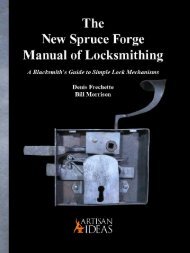Persian Locks: 1500 Years of Iranian Padlocks
In Iran, the padlock was developed in an amazing variety of sizes, shapes, materials, and mechanisms, the likes of which are less frequently encountered in Europe. On the whole, very little attention has been devoted to the history and development of the lock in Iran. Parviz Tanavoli, Iran's leading sculptor, was first attracted to the locks of his own country because of their sculptural qualities. In this beautiful and informative book the author shares with us, in over 500 photos and drawings, the most interesting examples of locks from his famous collection which was first introduced to the American public by the Smithsonian Institute on the occasion of the American Bicentennial. You will also find detailed drawings which clearly illustrate the workings of the various locking mechanisms (e.g., barbed-spring, helical-spring, notched-shackle, hook and revolving catch, etc.) used in the locks in this book. All locks are dated and when known, the place of manufacture is given. A smaller version of this updated and expanded book was published by The Smithsonian Institution in 1976 with the title, "Locks from Iran: Pre-Islamic to Twentieth Century." In 2019 and 2020 the author edited his original book adding new text and a great number of new high-quality photos of locks which have been added to his collection in the 44 years since the first book was published. Hardcover, 144 pages, 10-inches x 8.5-inches, over 500 photos and drawings.
In Iran, the padlock was developed in an amazing variety of sizes, shapes, materials, and mechanisms, the likes of which are less frequently encountered in Europe. On the whole, very little attention has been devoted to the history and development of the lock in Iran.
Parviz Tanavoli, Iran's leading sculptor, was first attracted to the locks of his own country because of their sculptural qualities. In this beautiful and informative book the author shares with us, in over 500 photos and drawings, the most interesting examples of locks from his famous collection which was first introduced to the American public by the Smithsonian Institute on the occasion of the American Bicentennial. You will also find detailed drawings which clearly illustrate the workings of the various locking mechanisms (e.g., barbed-spring, helical-spring, notched-shackle, hook and revolving catch, etc.) used in the locks in this book. All locks are dated and when known, the place of manufacture is given.
A smaller version of this updated and expanded book was published by The Smithsonian Institution in 1976 with the title, "Locks from Iran: Pre-Islamic to Twentieth Century." In 2019 and 2020 the author edited his original book adding new text and a great number of new high-quality photos of locks which have been added to his collection in the 44 years since the first book was published.
Hardcover, 144 pages, 10-inches x 8.5-inches, over 500 photos and drawings.
You also want an ePaper? Increase the reach of your titles
YUMPU automatically turns print PDFs into web optimized ePapers that Google loves.
Talisman<br />
Date range: 18th–20th centuries; Place <strong>of</strong> manufacture: all regions <strong>of</strong> Iran; Materials: silver, steel,<br />
brass; Mechanisms: barbed-spring, bent-spring, helical-spring; Size range: (width) min. 1 cm, max. 2.5 cm<br />
(height) min. 2.5 cm, max. 6.5 cm.<br />
<strong>Locks</strong> meant to be used as talismans were made in the past by town and village locksmiths all over<br />
Iran, as well as by itinerant metalworkers such as gypsies. Most <strong>of</strong> these talismanic locks are made<br />
<strong>of</strong> silver or steel or, occasionally, <strong>of</strong> brass. The usual mechanism is a single barbed-spring attached<br />
to the free end <strong>of</strong> the top shackle (see p. 22, Fig. 26, 26a). Due to the smallness <strong>of</strong> these locks, their<br />
keys are <strong>of</strong>ten nothing more than a pin.<br />
The purpose <strong>of</strong> such locks is to protect the owner from evil and to assure success and well-being<br />
through the religious formulas engraved by the locksmith (for more information on other talismanic<br />
objects see: Tanavoli, Talisman, 2006). Inscriptions are made in two ways: one in the characters <strong>of</strong><br />
<strong>Persian</strong> writing, the other using the ancient abjad system in which a numerical value is assigned to<br />
each letter <strong>of</strong> the alphabet. Writing can therefore be done by the use <strong>of</strong> conventional letters or by<br />
numbers. When “encoded” in the latter fashion, the special wish or hope <strong>of</strong> the owner is more easily<br />
concealed. Fig. 8 (page 13) is interesting because <strong>of</strong> the two human figures, side by side, engraved<br />
on it in addition to the usual numbers. This was <strong>of</strong>ten done to gain the affection, friendship, or<br />
goodwill <strong>of</strong> another party.<br />
Those locks with barbed-springs seem to have been meant as talismans from the beginning, while<br />
those with bent-springs (Nos. 413–420) appear to have been engraved for this purpose later.<br />
<strong>Locks</strong> 413, 414. Two brass talisman locks with bentspring<br />
mechanisms, 19th–20th centuries. Width 2.8 cm,<br />
height (left) 3.7 cm (right) 6.5 cm.<br />
<strong>Locks</strong> 415, 416. Two steel talisman locks with bentspring<br />
mechanisms, 17th–18th centuries. Width 2.6 cm,<br />
height (left) 4.7 cm (right) 4.5 cm.<br />
133










